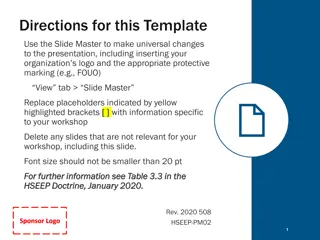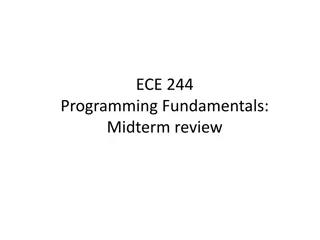MIDTERM REVIEW
Abstraction Functions play a crucial role in software design by mapping concrete representations to abstract values, aiding in showcasing code correctness. Through examples like representing playing cards and geometric shapes, this content delves into the importance of Abstraction Functions in ensuring effective code structuring and separation of concerns. Explore the concepts of AF, R.A.R, and the significance of documenting specifications for clear communication and code maintenance. Backwards and forwards reasoning techniques are also explored to enhance problem-solving skills in software engineering.
Download Presentation

Please find below an Image/Link to download the presentation.
The content on the website is provided AS IS for your information and personal use only. It may not be sold, licensed, or shared on other websites without obtaining consent from the author.If you encounter any issues during the download, it is possible that the publisher has removed the file from their server.
You are allowed to download the files provided on this website for personal or commercial use, subject to the condition that they are used lawfully. All files are the property of their respective owners.
The content on the website is provided AS IS for your information and personal use only. It may not be sold, licensed, or shared on other websites without obtaining consent from the author.
E N D
Presentation Transcript
Abstraction Functions Internal (like the representation invariant) Client doesn t need this! Can be used to show code correctness when combined with spec and rep invariant Maps concrete representation to abstract value
Abstraction Functions AF: R A R: Set of objects Consists of fields in the class; concrete, code A: Set of abstract objects What the object means; abstract, conceptual AF: References internal code representation Can contain calculations, etc that the client doesn t care about
Abstraction Functions public class Line { private Point start; private Point end; } // AF(r) = line l such that // l.start = r.start // l.end = r.end
Abstraction Functions /** * Card represents an immutable playing card. * @specfield suit: {Clubs,Diamonds,Hearts,Spades} * @specfield value: {Ace,2,...,Jack,Queen,King} */ public class Card { private int index; } // suit = S(index div 13) // where S(0)=Clubs, S(1)=Diamonds, // value = V(index mod 13) // where V(1)=Ace, V(2)=2, ..., // V(12)=Queen, V(0)=King
Specification strength Stronger specification is: Easier or harder for the client to use? Easier or harder for the implementer to specify? To weaken a specification, you can: Strengthen or weaken the preconditions? Strengthen or weaken the postconditions?
Documentation class IntegerSet { private List<Integer> set = new LinkedList<Integer>(); } public boolean contains(int x) { int index = set.indexOf(x); if (index != -1) { set.remove(index); set.add(0, x); } return index != -1; } @requires? @modifies? @effects? @return? @throws?
Backwards Reasoning { (x * y) * yn-1 = b } => { x * yn = b } x = x * y; { x * yn-1= b } n = n - 1; { x * yn = b }
Forwards Reasoning { |x| > 2 } x = x * 2; { |x| > 4 } x = x 1; { x > 3 | x < -5 }
CoinPile Class class CoinPile { private List<Integer> coins; public CoinPile() { coins = new ArrayList<Integer>(); } ... // many more methods for adding and removing coins, computing change, etc. }
CoinPile Class class CoinPile { private List<Integer> coins; public CoinPile() { coins = new ArrayList<Integer>(); } ... // many more methods for adding and removing coins, computing change, etc. } Representation invariant? Abstraction function? @specfield pennies: int @specfield nickels: int @specfield dimes: int @specfield quarters: int
CoinPile Class, contd @returns a list of coins with one coin of value n for each coin in this with value n (i.e., the list of coins in this) public List<Integer> getCoins() { return new ArrayList<Integer>(coins); } Representation exposure?


















